Factors affecting early growth of Nile tilapia fry in hapa-in-pond environments

Citation
Charo-Karisa, H.; Rezk, M.A.; Bovenhuis, K. (2005). Factors affecting early growth of Nile tilapia fry in hapa-in-pond environments. In: Hendry, C.I., Van Stappen, G.;Wille, M., Sorgeloos, P. (eds.) Fish and Shellfish Larviculture Symposium, European Aquaculture Society, special publication 36, Oostende, Belgium
Hapas, usually suspended in fertilized ponds, have long been used for tilapia fry production (Santiago et al., 1985; Bhujel, 1997) and recently for fry rearing. In fish breeding programs, members of a full-sib family usually share a common tank or hapa prior to tagging and communal testing. This tends to increase resemblance between family members which may reduce the efficiency of breeding programs. For convenience of monitoring and identification of families, hapas are often arranged in rows over the pond. If ponds are heterogeneous, for example with respect to nutrient availability, the spatial arrangement of hapas may create an environmental correlation among neighbouring units. The aim of this study was to quantify the common environmental and genetic effects on early rearing stages of tilapia in hapa-in-pond nursing conditions.
Permalink
Date Available
Type
Publisher
Research Themes
Topics
Language